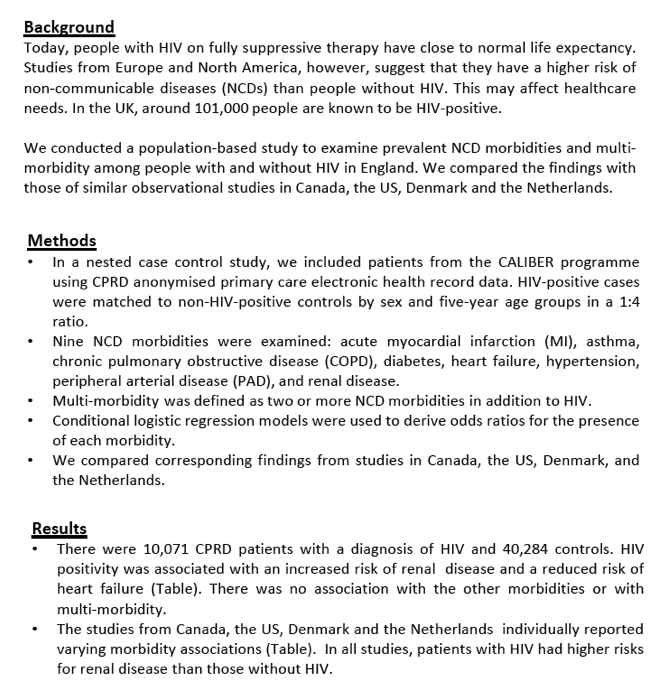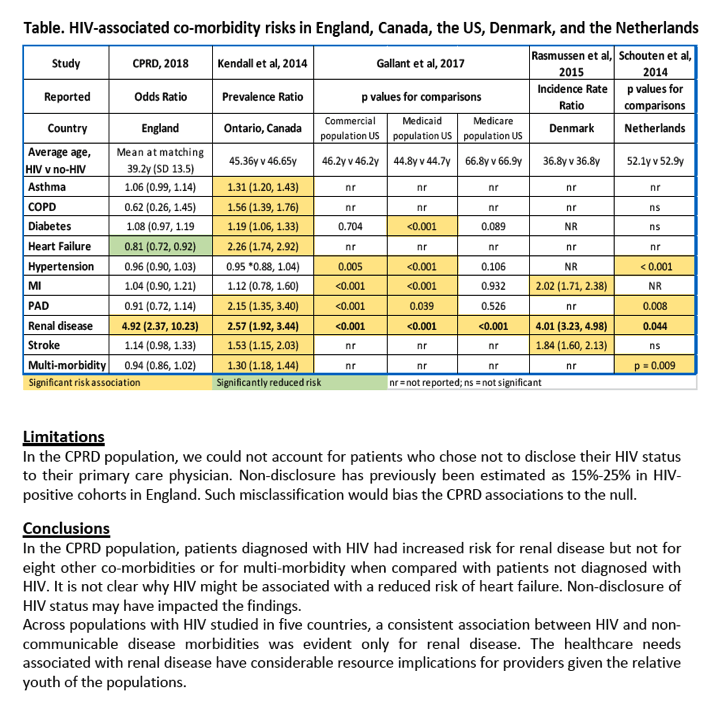 |
 |
 |
| |
Noncommunicable disease rates with HIV lower in England than in 4 other countries
|
| |
| |
22nd International AIDS Conference, Amsterdam, Netherlands, July 23-27, 2018
Mark Mascolini
Analysis of 50,000 people with or without HIV in England found a higher risk of only 1 noncommunicable disease (NCD) with HIV--kidney disease [1]. In contrast, HIV-positive people in Canada, the United States, Denmark, and the Netherlands had higher rates of 3 of more of the 9 NCDs studied. Kidney disease proved more frequent with HIV in all 5 countries.
Despite improved survival with HIV over the past decade, non-HIV comorbidities continue to affect higher proportions of HIV-positive people than the general population in many studies. Researchers at London's Barts Health NHS Trust and other centers compared comorbidities with and without HIV in a large population in England and compared their findings with results from 4 other high-income countries: Canada [2], the United States [3], Denmark [4], and the Netherlands [5].
The English population included 10,071 HIV-positive people in the CALIBER program matched by sex and 5-year age group to 40,284 HIV-negative controls. Researchers used conditional logistic regression models to compare prevalence of 9 NCDs in people with versus without HIV: asthma, chronic obstructive pulmonary disease (COPD), diabetes, heart failure, hypertension, myocardial infarction (MI), peripheral arterial disease, kidney disease, and stroke. They defined multimorbidity as 2 or more NCDs in addition to HIV. Then they compared their results with recent findings in Canada [2], the United States [3], Denmark [4], and the Netherlands [5]. Sizes of those populations are listed in the references.
Analysis of the English cohort found only 1 NCD more frequent in people with HIV: Kidney disease proved 5 times more likely with HIV (adjusted odds ratio [aOR] 4.92, 95% confidence interval [CI] 2.37 to 10.23). There were trends toward higher risks of asthma (aOR 1.06, 95% CI 0.99 to 1.14) and stroke (aOR 1.14, 95% CI 0.98 to 1.33) with HIV. Heart failure was about 20% less frequent with than without HIV (aOR 0.81, 95% CI 0.72 to 0.92). Multimorbidity did not affect more people with HIV (aOR 0.94, 95% CI 0.86 to 1.02).
In contrast, HIV-positive groups in each of the other 4 countries ran a higher risk of 3 or more NCDs. The Canadian study saw higher risks of asthma, COPD, diabetes, heart failure, peripheral arterial disease, kidney disease, stroke, and multimorbidity in the HIV population [2]. In Denmark MI, kidney disease, and stroke proved more frequent with HIV infection [4]. People with HIV in the Netherlands ran a higher risk of hypertension, peripheral arterial disease, kidney disease, and multimorbidity [5].
The US study analyzed 3 groups of people--those with commercial insurance, those on Medicaid, and those on Medicare [3]. Kidney disease affected HIV-positive people more often in all 3 groups. Commercially insured people with HIV also ran a higher risk of hypertension, MI, and peripheral arterial disease. Medicaid users with HIV had higher rates of those 3 conditions and diabetes.
The English investigators noted that their analysis suffers from at least 1 limitation. Nondisclosure of HIV status in their study population could have resulted in misclassification of HIV-positive people as HIV-negative. The lower heart failure rate with HIV is puzzling, they added. The only other study that assessed heart failure, in Canada, found a twice higher risk with HIV (aOR 2.26, 95% CI 1.74 to 2.92). A large US analysis presented at AIDS 2018 and reviewed separately by NATAP calculated a 50% or higher risk of incident heart failure risk in people with versus without HIV [6].
The 5-country unanimity in finding a higher kidney disease risk with HIV leads the authors of this study to stress that "the healthcare needs associated with renal disease have considerable resource implications for providers given the relative youth of the populations."
References
1. McGettigan P, Daskalopoulou M, Denaxas S, Matin N. Morbidity among HIV-positive people: A population-based study in 43,545 UK patients. AIDS 2018: 22nd International AIDS Conference, Amsterdam, Netherlands, July 23-27, 2018. Abstract TUPEB085.
2. Kendall CE, Wong J, Taljaard M, et al. A cross-sectional, population-based study measuring comorbidity among people living with HIV in Ontario. BMC Public Health. 2014;14:161. 14,005 HIV+/71,410 HIV-
3. Gallant J, Hsue PY, Shreay S, Meyer N. Comorbidities among US patients with prevalent HIV infection--a trend analysis. J Infect Dis. 2017;216:1525-1533. 36,298 HIV+ patients covered by commercial payers, 26,246 covered by Medicaid, and 1854 covered by Medicare
4. Rasmussen LD, May MT, Kronborg G, et al. Time trends for risk of severe age-related diseases in individuals with and without HIV infection in Denmark: a nationwide population-based cohort study. Lancet HIV. 2015;2:e288-298. 5897 HIV+/53,073 HIV-
5. Schouten J, Wit FW, Stolte IG, et al. Cross-sectional comparison of the prevalence of age-associated comorbidities and their risk factors between HIV-infected and uninfected individuals: the AGEhIV cohort study. Clin Infect Dis. 2014;59:1787-1797. 540 HIV+/524 HIV-
6. Go AS, Horberg M, Reynolds K, et al. HIV infection independently increases the risk of developing heart failure: The HIV HEART study. AIDS 2018: 22nd International AIDS Conference, Amsterdam, Netherlands, July 23-27, 2018. Abstract THAB0103. 38,868 HIV+/386,586 HIV-
-----------------------------------------
Morbidity among HIV-positive people: a population-based study in 50,000 UK patients
McGettigan P1, DaskalopoulouM2, DenaxasS2, Matin N3
1William Harvey Research Institute, London;2Institute of Health Informatics, University College London;
3Barts Health NHS Trust, London, United Kingdom


|
| |
|
 |
 |
|
|